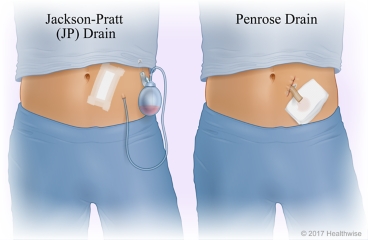
Your Care Instructions
After a surgery, fluid may collect inside your body in the surgical area. This makes an infection or other problems more likely. A surgical drain allows the fluid to flow out.
The doctor puts a thin, flexible rubber tube into the area of your body where the fluid is likely to collect. The rubber tube carries the fluid outside your body.
The most common type of surgical drain carries the fluid into a collection bulb that you empty. This is called a Jackson-Pratt (JP) drain. The drain uses suction created by the bulb to pull the fluid from your body into the bulb. The rubber tube will probably be held in place by one or two stitches in your skin. The bulb will probably be attached with a safety pin to your clothes or near the bandage so that it doesn't flip around or pull on the stitches.
Another type of drain is called a Penrose drain. This type of drain doesn't have a bulb. Instead, the end of the tube is open. That allows the fluid to drain onto a dressing taped to your skin. The drain may be kept in place next to your skin with a stitch or a safety pin in the tube.
When you first get the drain, the fluid will be bloody. It will change colour from red to pink to a light yellow or clear as the wound heals and the fluid starts to go away.
Your doctor may give you information on when you no longer need the drain and when it will be removed.
Follow-up care is a key part of your treatment and safety. Be sure to make and go to all appointments, and call your doctor or nurse advice line (811 in most provinces and territories) if you are having problems. It's also a good idea to know your test results and keep a list of the medicines you take.
How do you empty the bulb of a Jackson-Pratt drain?
Follow any instructions your doctor gives you. How often you empty the bulb depends on how much fluid is draining. Empty the bulb when it is half full.
- Wash your hands with soap and water.
- Take the plug out of the bulb.
- Empty the bulb.
If your doctor asks you to measure the fluid, empty the fluid into a measuring cup, and write down the colour and how much you collected. Your doctor will want to know this information.
- Clean the plug with alcohol.
- Squeeze the bulb until it is flat.
This removes all the air from the bulb. You may need to put the bulb on a table or a counter to flatten it.
- Keep the bulb flat, and put the plug in.
The bulb should stay flat after you put the plug back in. This creates the suction that pulls the fluid into the bulb.
- Empty the fluid into the toilet.
- Wash your hands.
How do you change the dressing around your surgical drain?
You may have a dressing (bandage). The dressing is often made of gauze pads held on with tape. Your doctor will tell you how often to change it.
- Wash your hands with soap and water.
- Take off the dressing from around the drain.
- Clean the drain site and the skin around it with soap and water.
Use gauze or a cotton swab.
- When the site is dry, put on a new dressing.
The way your dressing is put on depends on what kind of drain you have. You will get instructions for your type of drain.
- Wash your hands again with soap and water.
Your doctor may ask you to keep track of your dressing changes. Write down the time of day and the amount and colour of the fluid on the dressing.
How do you help prevent clogs in your surgical drain?
Squeezing or "milking" the tube of your surgical drain can help prevent clogs so that it drains correctly. Your doctor will tell you if and when you need to do this. In general, you do this when:
- You see a clot in the tube that prevents fluid from draining. The clot may look like a dark, stringy lining.
- You see fluid leaking around the tube where it goes into the skin.
Follow these steps for milking the tube.
- Use one hand to hold and pinch the tube where it leaves the skin.
- With the thumb and first finger of your other hand, pinch the tube just below where you're holding it.
- Slowly and firmly push your thumb and first finger down the tubing toward the end of the tube.
- Repeat this as many times as needed to move the clot.
If you have a Jackson-Pratt (JP) drain, the clot should move down the tube and into the bulb. If you have a Penrose drain, the clot should move into the dressing.
When should you call for help?
Call your doctor or nurse advice line now or seek immediate medical care if:
- You have signs of infection, such as:
- Increased pain, swelling, warmth, or redness around the area.
- Red streaks leading from the area.
- Pus draining from the area.
- A fever.
- You see a sudden change in the colour or smell of the drainage.
- The tube is coming loose where it leaves your skin.
Watch closely for changes in your health, and be sure to contact your doctor or nurse advice line if:
- You see a lot of fluid around the drain.
- You cannot remove a clot from the tube by milking the tube.
Where can you learn more?
Go to https://www.healthwise.net/patientEd
Enter K117 in the search box to learn more about "Surgical Drain Care: Care Instructions".
